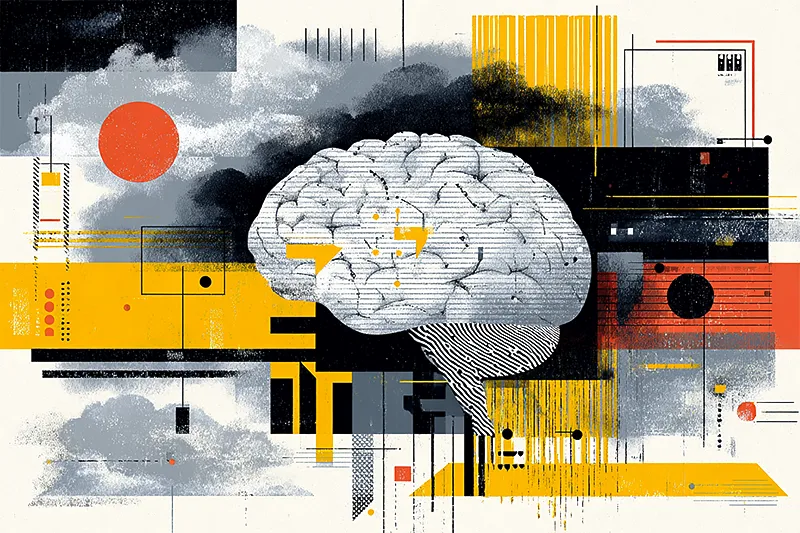Why your brain doesn’t come with a user manual (and everyone’s pretending to read it anyway)
There’s something deeply human about the way we fumble in the dark when it comes to understanding our own minds. We live in an age where you can diagnose your car’s engine trouble with an app, but only 28% of people can accurately recognize the symptoms of mental illness, even when it’s happening inside their own heads. The paradox is almost poetic: the organ responsible for all human understanding struggles most to understand itself.
The invisible wound nobody taught us how to see
Imagine trying to explain color to someone who’s only ever seen in grayscale. That’s what talking about mental health feels like in a world built for the neurotypical. It’s like asking a person living in flatland to comprehend a sphere passing through their two-dimensional reality. They can see the circle where it touches their plane, but the fullness, the depth, the way it curves through dimensions they’ve never inhabited… that remains invisible.
Recent research reveals we’re facing a crisis of comprehension that runs deeper than simple ignorance. It’s woven into the very fabric of how our brains process the abstract, the invisible, the deeply internal.
Here’s what breaks my heart: 970 million people globally live with a mental disorder, yet only one-third of those with depression ever receive formal care. Not because help doesn’t exist, but because we’ve built a world where understanding mental illness requires a PhD in neuroscience, a trust fund for therapy, and the emotional bandwidth to navigate a system that speaks in clinical riddles while your brain is already fighting itself.
The numbers tell a story of collective confusion. When researchers asked people to identify schizophrenia symptoms, most still believed the Hollywood myth of “split personality.” Meanwhile, 86.9% of young people with major depression think they should just handle it themselves. As if willpower could mend a broken neurotransmitter the way duct tape fixes a leaky pipe. We’re trying to use hammers on software bugs, wondering why nothing’s getting fixed.
Your generation isn’t broken, the measuring stick is
There’s this narrative floating around that Gen Z is somehow more fragile, that we’ve traded resilience for therapy speak. But here’s the plot twist the data reveals: we’re not breaking more. We’re just the first generation refusing to hide the cracks.
Consider this generational divide like tectonic plates shifting beneath our feet. 65% of Gen Z reports experiencing mental health challenges compared to just 14% of Baby Boomers. But dig deeper and you’ll find older generations are twice as likely to blame decreased resilience rather than acknowledge the objective reality of economic precarity, climate anxiety, and digital overwhelm. They’re measuring our struggles with rulers from a different century, then wondering why the numbers don’t add up.
What’s actually happening is a linguistic revolution. Where previous generations whispered about “nervous breakdowns” behind closed doors, we’re creating new vocabularies for internal experiences. We say “I’m dissociating” instead of “spacing out.” We recognize “emotional dysregulation” instead of dismissing ourselves as “too sensitive.” This isn’t weakness. It’s precision. It’s like finally getting glasses after years of squinting at blurry shapes and being told that’s just how the world looks.
The empathy gap between minds that work differently
Understanding mental illness when you haven’t experienced it is like trying to understand water when you’ve never been thirsty. Our brains literally process this information differently. Neuroimaging shows that abstract concepts of mental distress activate different neural pathways than concrete, visible ailments. Your brain can easily comprehend a broken bone because it can see the X-ray, imagine the pain, visualize the cast. But try to grasp the weight of depression, that gravitational pull that makes lifting a spoon feel like bench-pressing the world, and suddenly comprehension becomes quicksand.
The research reveals something profound: contact with people who have lived experience is the single most effective way to build understanding. Not pamphlets, not awareness weeks, not celebrity PSAs. Actual human connection. When you know someone, really know them, and watch them navigate mental illness with the same dignity they’d bring to any other health condition, the abstract becomes tangible. The scary becomes familiar. The other becomes us.
This is why representation matters beyond buzzword status. Every time someone shares their story, whether it’s Senator John Fetterman discussing depression from the halls of power or your friend posting about their therapy wins on Instagram, they’re building bridges across the empathy gap. They’re teaching our pattern-recognition machines (aka brains) that mental illness doesn’t look like movie villains or tragic heroes. It looks like Tuesday. It looks like your co-worker, your sister, the person serving your coffee.
When culture speaks a different language for pain
Mental health doesn’t translate cleanly across cultures. It’s more like poetry, where meaning shapeshifts with context. In some Asian cultures, depression might wear the mask of physical pain because expressing emotional distress directly would disturb social harmony. Hispanic communities might experience “ataques de nervios,” episodes that Western psychiatry struggles to categorize because they exist outside our diagnostic dictionary.
The mental health system was built by and for a specific cultural context. Predominantly white, Western, individualistic. It assumes you process emotions through talking, that you trust institutions, that seeking help is a sign of strength rather than bringing shame to your family. But only 36% of Hispanic adults and 39% of Black adults with mental health challenges receive services, compared to 50% of white adults. This isn’t about one culture being more mentally healthy than another. It’s about a system speaking one language while millions of people dream in another.
Rural communities face their own translation crisis. When your nearest therapist is 80 miles away and everyone in town knows your truck, the very act of seeking help becomes a public declaration. The research shows rural areas have similar rates of mental illness but vastly different relationships with treatment. Here, mental health understanding gets filtered through lenses of self-reliance, faith-based healing, and community reputation. None of which appear in the DSM-5.
Why your Instagram feed might understand you better than your doctor
Plot twist: social media, that alleged destroyer of mental health, might actually be revolutionizing how we understand it. TikTok therapists reach millions with bite-sized explanations that make complex neuroscience accessible. Instagram accounts run by actual psychiatrists translate medical journals into meme format. The comment sections become support groups, impromptu education sessions, collective processing spaces.
But here’s where it gets complicated and fascinating. These platforms create what researchers call parasocial relationships, where you feel genuinely connected to someone you’ve never met. When Dwayne “The Rock” Johnson talks about his depression, your brain processes it similarly to a friend’s disclosure. These one-sided emotional connections actually reduce stigma and increase help-seeking behavior. It’s like having a practice round for empathy, a low-stakes way to encounter mental health stories before you need to support someone (or yourself) in real life.
The dark side? Algorithms designed for engagement, not education. Teens on TikTok might get genuinely helpful content about anxiety or spectacularly wrong information about self-diagnosis, and the platform doesn’t distinguish. We’re crowd-sourcing mental health literacy from a mixture of licensed professionals, well-meaning advocates, and people who think they’re experts because they read a Twitter thread once. It’s democracy meets mental health: messy, imperfect, but more accessible than anything that came before.
In this chaotic landscape, tools like Undelulu emerge as gentle guides. An AI mental health companion available 24/7, offering support when therapists are sleeping and crisis lines are busy. It’s not replacing human connection, but creating a bridge between the overwhelming noise of social media and the often inaccessible world of professional care. Sometimes understanding begins with having someone (or something) listen without judgment, available at 3am when your thoughts spiral like autumn leaves in a storm.
The revolution will be peer-supported
Here’s what gives me hope: we’re witnessing the emergence of solutions that actually work, and they look nothing like traditional top-down education. The most effective interventions combine lived experience storytelling with interactive learning, creating spaces where understanding grows from connection rather than curriculum.
Digital mental health literacy programs now show effect sizes comparable to in-person therapy. Community art programs reduce stigma more effectively than clinical interventions. Peer support networks, people who’ve been there guiding others through, consistently outperform professional-only approaches in building genuine understanding.
The breakthrough isn’t in the technology or the technique. It’s in the philosophy. We’re moving from “let me explain your illness to you” to “let me show you my recovery.” From “here’s what’s wrong with your brain” to “here’s how we can work with the brain you have.” The most successful programs recognize that mental health literacy isn’t about memorizing symptoms. It’s about recognizing humanity in experiences that feel inhuman.
What works? Programs that speak your language, literally and figuratively. Mental Health First Aid adapted for specific communities. Born This Way Foundation’s certificate program reaching 1.5 million college students. Workplace interventions designed for male-dominated industries that focus on helping your buddy rather than fixing yourself. Each successful approach treats mental health understanding as a skill you practice, not information you download.
The hope hiding in plain sight
The research reveals something unexpected: understanding mental health isn’t actually that hard. What’s hard is unlearning the myths, overcoming the fear, and bridging the experiential gaps. When interventions address these root causes through contact, through story, through culturally resonant approaches, comprehension follows naturally.
We’re living through a pivotal moment where mental health is transitioning from shadow to spotlight. Yes, 75% of Americans believe mental health conditions are treated worse than physical health issues. But that same statistic means three-quarters of us recognize the problem. Recognition is the first step toward revolution.
The path forward isn’t about making everyone mental health experts. It’s about making mental health human. It’s about creating languages for internal experiences that don’t require medical degrees to understand. It’s about telling stories that make the invisible visible, the abstract tangible, the scary familiar.
Your brain might not come with a user manual, but we’re collectively writing one, one vulnerable conversation, one shared story, one moment of recognition at a time. The beauty is that we don’t need perfect understanding. We just need enough to reach for each other across the gap. Enough to say “I see you struggling with something I might not fully understand, but I’m here anyway.”
Because in the end, mental health literacy isn’t about knowing all the answers. It’s about finally admitting that we’re all making it up as we go, finding words for feelings that predate language, building bridges across the canyons in our minds. And maybe that’s the most human thing of all: this fumbling toward understanding, this collective effort to make sense of the senseless, to find meaning in the chaos between our ears.
The revolution isn’t coming. It’s here, living in every conversation that starts with “Actually, I’ve been struggling too.”
With gentleness for wherever you are
on this journey of understanding,
The Undelulu Team```w
 Sometimes all you need is three chords and the truth.
Sometimes all you need is three chords and the truth. 